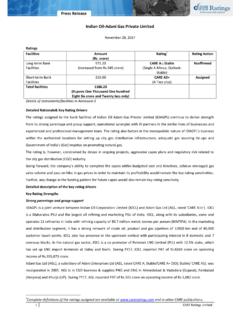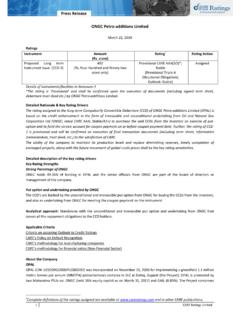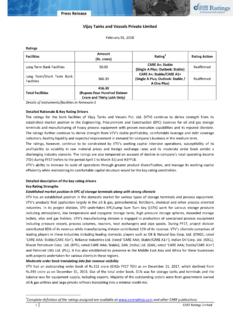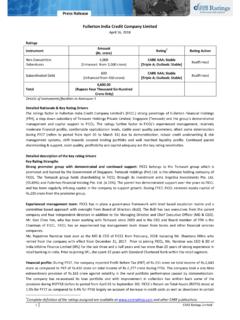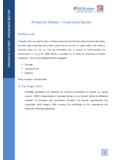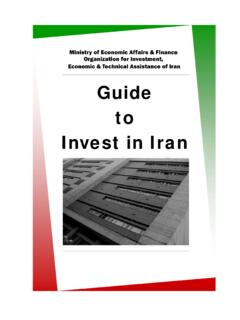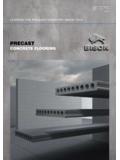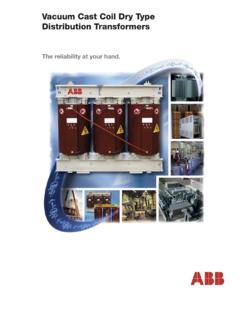Transcription of Autoclaved Aerated Concrete (AAC) Block: …
1 Autoclaved Aerated Concrete (AAC) block : conquering brick by brick Ratings August 05, 2015. Background Autoclaved Aerated Concrete (AAC) block is a newly-adopted green building material in India which is used as a substitute of the conventional red clay bricks in residential, commercial and industrial construction activities. Globally, AAC was originally invented in early 1923 in Sweden, and has been around for over 90 years. Although AAC was invented to overcome the shortage of timber in Sweden, the product has found global acceptance. Since then, AAC has been used extensively in Europe, Asia and USA. AAC block is a light weight precast building material that provides both construction economy and speed. It is also an environment friendly product, as it is manufactured using 60-65% of fly ash (by weight), an unavoidable waste from coal/lignite-based thermal power plants.
2 Due to its many desirable attributes, AAC block is gaining popularity in India now-a-days as a replacement of the traditional fired clay brick. Industry structure and development Indian construction industry is one of the most important sectors of the economy as it stimulates building infrastructure and creates growth opportunities for other sectors in the economy. The construction sector contributes around 8% in GDP and registered an annual growth of during FY15. (Source: MoSPI) The building materials sector is a key constituent of the construction industry. Economic growth and demand for building materials usually moves in tandem. Driven by recent growth in infrastructure and construction activities, the building material sector has recorded considerable growth over the last few years. Moreover, India's improving economic growth, expanding population along with rapid increase in per capita income, industrialisation and urbanisation signals good growth prospects for this sector.
3 1. Ratings However, environmental conservation has also become a key focus area simultaneously, as traditional building material fired clay brick consumes lots of fertile land as raw material and emits huge quantity of greenhouse gases. Due to inherent drawbacks of fired clay brick manufacturing process, the emphasis on environment sustainability is growing which is thus expected to spur demand for green building materials like AAC block . Indian conventional red clay brick sector Clay bricks form the backbone of the Indian construction industry, which is valued at approximately lakh crore for FY15 (Source: MoSPI). India has the world's second largest brick manufacturing industry after China, accounting for more than 10% of the global production. Brick-making is also one of the most unorganised sectors in India which is also significantly large in size and spread.
4 India is estimated to have over 150,000. registered/unregistered brick kilns satisfying an annual demand of over 200 billion bricks which translates into an estimated industry size of more than ,000 crore. It has also continuously grown over the years on account of a rapid increase in the demand for physical buildings and infrastructure. Red clay brick manufacturing depends on soil as its major raw material and coal & other biomass as fuel. It is estimated that the brick industry consumes around 350 million tonnes of good quality soil and around 25 million tonnes of coal (fourth largest consumer of coal after power, steel and cement sector) along with huge quantity of biomass fuels every year. Clay brick manufacturing is a major source of environment pollution as it consumes fertile land and emits greenhouse gases (carbon dioxide CO2) affecting air, agriculture and vegetation.
5 India's red clay brick sector is characterised by traditional firing technologies, reliance on manual labour and low mechanisation rate together with the dominance of small-scale brick kilns, single raw material (clay) and lack of institutional capacity for the development of the sector. Considering the mentioned factors along with the market size and demand potential of brick in construction activities, several opportunities exist in Indian brick industry to improve resource efficiencies and promoting green building technologies such as fly ash-based AAC block . AAC block : an emerging green building material in India AAC block , which is also known as Autoclaved cellular Concrete or Autoclaved lightweight Concrete or Aerated brick, is an eco-friendly building material used in construction activities. AAC block offers a unique combination of strength, low weight, cost-effectiveness and durability compared with a clay brick.
6 It is a steam-cured mixture of fly ash, cement, lime and aeration agent. Other AAC products include wall panels, floor and roof panels and lintels. Autoclaved Aerated Concrete (AAC) block : conquering brick by brick 2. Ratings Although AAC block has been in use since long globally, the AAC block is an emerging product and a growing industry in India. Currently, AAC products are manufactured in more than 40 countries and are used in more than 70 countries. As of 2014, there are more than 3,000 AAC production facilities globally with an estimated production capacity of 450 million cubic meters per annum (CMPA) (Source: ). Xella International GmbH is world's largest AAC manufacturer, while Biltech Building Elements Ltd. (rated CARE BBB') is India's largest AAC manufacturer. More AAC block plants are being set up across India as awareness about AAC.
7 block is growing. Salient features of AAC block : Leading to increasing acceptance of the product The following salient features of AAC block make it user-friendly product over other construction materials: Environment Makes productive use of unavoidable waste - fly ash. friendly Through the use of fly ash, AAC helps creation of a sustainable environment by reducing CO2. emissions, agricultural soil erosion and water pollution. Non-polluting manufacturing process does not exude gases, the only by-product is steam. Light weight Three to four times lighter than traditional clay bricks, therefore, easier and cheaper to transport. Lighter block makes construction easier and faster. Cost saving Being light weight, AAC reduces the dead weight of the building, resulting in to reduction in steel and cement on foundation structure work.
8 Also allows construction of taller buildings. AAC's light weight saves on labour cost. Being bigger in size than clay brick, AAC wall construction involves less joints; thus, overall savings on mortar work. Automatic manufacturing process gives AAC a dimensional accuracy and smooth surfaces, eliminating need of three-coat plaster walls and allow for a very thin final coat. Energy Efficient Energy consumption for producing AAC is less compared with production of other building materials. Tiny air pores and thermal mass of block provide thermal insulation, thus, reducing heating and air conditioning costs of a building. Easy workability Available in custom sizes. block can be easily cut or drilled to fit individual requirements. Accurate cutting minimises the generation of solid waste during use. Others High strength, less breakage and less wastage.
9 Fire resistant. Superior sound absorption due to porous structure of block . Pest and moisture resistant. Use of AAC block in construction activities offers interesting proposition for various segments of the society. For a project developer, an AAC block means faster construction along with cost saving; for an environmentally conscious peoples, it means eco-friendly product and for those who occupy buildings built with AAC block , it means better safety and lower energy costs for cooling or heating. Autoclaved Aerated Concrete (AAC) block : conquering brick by brick 3. Ratings A quick comparison between AAC block and clay brick Parameter AAC block Clay Brick Production State-of-the-art production facility Unhealthy working conditions due to emission of facility toxic gases Production cost beak-up Sector and labour Organised sector with statutory labour laws.
10 Unorganised sector with rampant use of child labour. Soil consumption Zero soil consumption. Primary raw material for One clay brick consumes more than three kgs of AAC block is fly ash which is industrial waste top soil. generated by coal/lignite-based thermal power plants (TPP). Fuel consumption One square feet with AAC block will consume 1 One square feet with clay brick will consume 8 kg and CO2 emission kg of coal. Lower greenhouse gas emission. of coal. Higher greenhouse gas emission. Size Available in custom sizes to fit individual Available in fixed size. requirements. Density 550-700 kg per cubic meter Around 1,800 kg per cubic meter Availability Available throughout the year. Since the drying and firing is done in open, the brick cannot be manufactured in rainy season;. hence, it is mostly seasonal and operating for around 8 months in a year.



